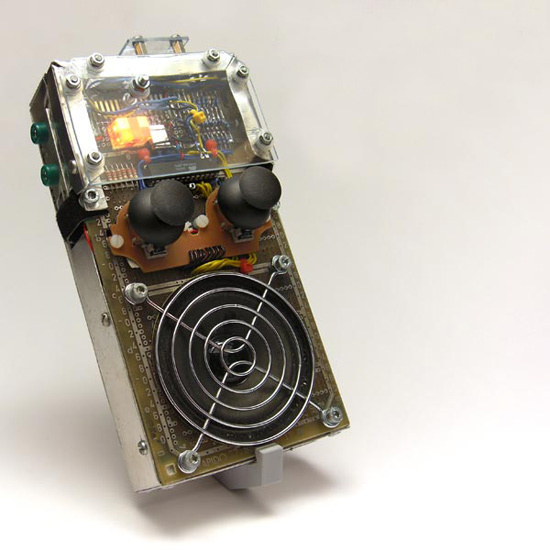Algorithmic synthesizers
The artist Niklas Roy has created various, what he calls algorithmic synthesizers. His PSP has an interface inspired on the Playstation controllers, and he tries to dissolve the boundaries of discrete music production units like samplers, synthesizers and sequencers. Instead he embarks on investigating the properties of binary algorithms where parameters are controlled all at once and heavily intertwined. The instrument is part of researching binary structures in music; e.g. comparing the relations between counting in different number systems and rhythmic patterns.
His Vektron Modular is a playback machine for compositions that are stored on microcontrollers. The Micro monster modular is an instrument he designed for another artist; again it is a playback system that can take compositions that are stored on microcontrollers, that can be played with in realtime. His interest is in finding different kinds of algorithms on minimal hardware that can compute the sound waves. In one of the modules for the micro monster modular he is playing with a simple formula inspired by the one-line code musical symphonies from the Finnish democoder Viznut, that by now have been called byte-beats.
PSP - Pocket Sound Performer
A hand held, all-in-one, highly versatile sound and music production device.

"The instrument dissolves the boundaries of discrete music production units like samplers, synthesizers and sequencers. The PSP’s interface is derived from a Playstation controller and lets the user influence all parameters at the same time. Volume, frequency, ADSR envelope and rhythm are all merged in the binary logic of this 6-bit device, leading to a music production experience where the operator plays more the role of a conductor and listener than the role of a classic musician. The internal 3W speaker makes the device truly independent and its six pixel graphics display entertains the user during his performance."
"The PSP is part of an ongoing theoretical and practical research of binary structures in music. Mathematical and sonic experiments accompany the research process. Here are two examples, which compare the relation between counting in different number systems and rhythmic beat structures."
Vektron Modular
A presentation of a modular, algorithmic synthesizer.

"The device plays compositions which are stored on microcontroller modules. The modules in this presentation are based on the Atmega family and are programmed in GCC (Arduino) and Bascom. In general, the synthesizer can work with any other TTL Microcontroller as PIC, Propeller or even ones which don't exist yet, as the computation happens on the module and the Vektron itself only provides the peripherals."


Micro Monster Modular
Arduino compatible algorithmic 6-bit sound synthesizer
"Since quite a while, I am fascinated by generating electronic sounds with microcontrollers. What interests me in particular, is calculating sound waves in real time by implementing different kinds of algorithms on minimal hardware. Those algorithms usually leave a few parameters open. The values of those parameters can be influenced manually on the fly with various faders and buttons."

"The second module implements the following formula:
output = t* (t >> (poti1>>4) | t >> (poti2>>4) )&((poti3>>3) +16)
“t” is a counter varible. It’ll be continuously incremented by 1 when you push one button, by 16 when you push the other button and by 17 when you push both buttons at the same time. The output of the looped calculations is low pass filtered with a ringbuffer. Poti number four determines the size of that buffer. While the formula looks a bit cryptic, it calculates results which can range from heavy noise to sequences of tones which comes quite close to a musical composition. A while ago, Finnish democoder Viznut researched what he called algorithmic symphonies from one line of code The formula which I used for this module goes in that direction. There are nice online tools which also visualize the output patterns of such formulae. Here’s a derivative of my little code which doesn’t need any poti or button inputs and creates an intersting melody:"
( t* (( t>>9| t>>13 ) & 15)) & 129
Sources:
Photos, videos, sound excerpts and cited texts (c) by the artist
